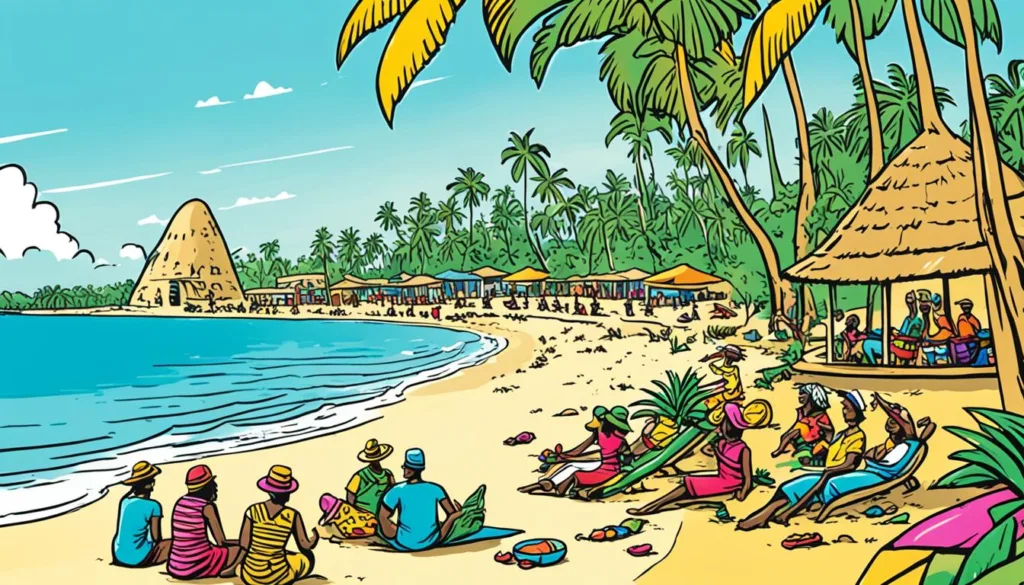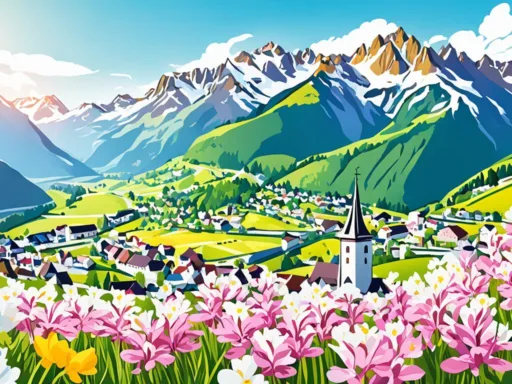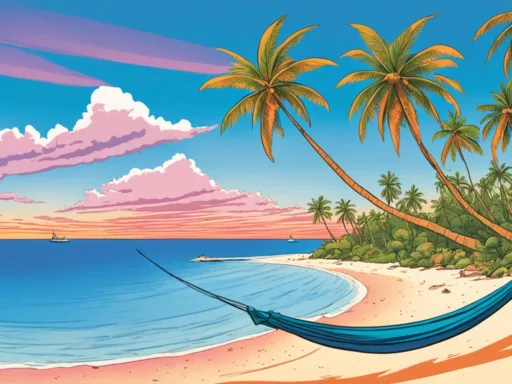Often overshadowed by its more famous neighbors, Togo remains one of West Africa’s least-visited nooks. But have you considered that this small sliver of a country might hold the keys to an unparalleled cultural and coastal odyssey? For those seeking the Best Time to Visit Togo, imagine a place where the weather is a perpetual embrace, where the sounds of rhythmic drumming float through the air, and where the coastline beckons with untouched tranquility. In this guide, we unpack Togo travel tips that will prepare adventurers for a West African adventure unlike any other. We reveal when the Togo weather is most welcoming, setting the stage for both festive celebration and serene relaxation.
Unlock the secrets to navigating the vibrant tapestry of Togo’s calendar, where cultural festivities flourish, and beaches remain blissfully secluded. Delve into the heart of Togo’s attraction, ascending from the jubilant rhythms of the Gbagba and Voodoo festivals to the soothing sands along its southern coast. Here’s where warm sunbeams meet the cool ocean breeze, and every traveler finds their haven of discovery—provided they know just when to go.
Key Takeaways
- Discovering the ideal travel window from November to February for a balanced experience of Togo’s climate and cultural events.
- Utilizing travel tips to immerse in the festivities like the Gbagba and Voodoo Festival amidst the best weather conditions.
- Uncovering the allure of Togo’s less frequented beaches for a unique coastal retreat.
- Exploring authentic Togolese cultural attractions away from the common tourist paths.
- Learning the importance of timing in experiencing West African adventure at its finest.
Understanding Togo’s Tropical Climate: A Guide for Travelers
Embarking on a Togolese journey involves more than just packing bags and booking flights; it requires an understanding of the local climate, which significantly influences the Togo vacation timing. With the country’s situation between the equator and the Tropic of Cancer, the Togo climate guide becomes an essential tool for anyone seeking the Best Time to Visit Togo.
The Seasonal Shifts: Planning Around Togo Weather
Visitors to Togo can expect a diverse climate that varies greatly from south to north. In the southern coastal areas, a tropical climate prevails with temperatures averaging around 27°C (81°F). As you venture to the north, the climate becomes notably drier and warmer, with temperatures often reaching upward of 30°C (86°F). To ensure a comfortable visit, timing your travel between November and April lets you avoid the rainy season that spans from May to October. This period is marked by a unique pattern in the south, where a brief respite occurs, known as the ‘little dry season’ from mid-July to mid-September.
Cultural Heatwaves: Festivals During the Togolese Year
Togo’s vibrant culture is on full display during its array of festive celebrations, adding another layer to the timing of your visit. Planning to witness the Gbagba festival in August or the renowned Togolese Voodoo Festival in September invites travelers to experience the rich traditions of the Togolese people. Both festivals exude an infectious energy, with mesmerizing dances, colorful displays, and the thrum of traditional music, offering a ‘different type of heat’ that permeates the visitor’s experience.
For nature enthusiasts, the period between November and April is perfect for visiting the stunning biodiversity of Fazao-Malfakassa National Park. This timeframe avoids the heavy rains and ensures the park’s trails and attractions are readily accessible. If you’re looking to immerse yourself in nature’s splendor and cultural magnificence, syncing your Togo vacation timing with these periods is key for an unparalleled Togolese adventure.
Exploring the Vibrancy of Togolese Culture
Embarking on a journey through Togo is akin to stepping into a vibrant tapestry woven by over forty distinct ethnic groups, each adding a unique thread to the country’s rich cultural cloth. The Togo tourist season presents travelers with a unique opportunity to witness and partake in a multitude of authentic traditional practices that undoubtedly become the highlight of any trip.
In Lomé, the heartbeat of Togo’s culture pumps through the streets and markets, particularly the Akodessewa Voodoo Market. Sightseers looking for Togo travel tips will find that a visit to this market offers an unparalleled glimpse into the mystical world of Voodoo, an integral part of Togolese heritage. Here, locals divulge in age-old customs, and the air is thick with the essence of a profound spirituality.
As you venture northwards, the ancient town of Notsé provides a compelling exploration of the Ewe culture, while majestic mountain mud hut villages carved by the Kabye people offer a stark contrast to the cityscapes. Nearby, you are invited to discover the Tamberma or Batammariba’s fortress-like settlements, a testament to the ingenuity of Togo’s builders and protectors, bearing UNESCO’s seal of a World Heritage site.

For those seeking to dive deeper into Togo cultural experiences, it is highly recommended to mingle with local families and immerse oneself in the customary greetings and farewells, a sign of respect and appreciation for their traditions. Culinary adventurers are encouraged to not just taste but also share in the processes of preparing and enjoying Togolese cuisine. This is often where the real magic happens—stories are shared, laughter is exchanged, and bonds are forged.
| Togolese Cultural Element | Description | Location |
|---|---|---|
| Voodoo Ceremonies | Authentic rituals that provide insight into the spiritual practices of Togo. | Akodessewa, Lomé |
| Kabye Mountain Villages | Historical mud hut villages showcasing traditional Kabye architecture. | Mountains north of Kara |
| Tamberma Fortress Settlements | UNESCO-protected, these fortress homes are indicative of Togo’s ancient defensive strategies. | Near Kara |
| Ewe Culture Insight | An exploration of the customs and traditions of the Ewe ethnic group. | Notsé |
The best time to witness these wonders is during the Togo tourist season, which typically runs from November to February. This period not only promises favorable weather but also a chance to celebrate with locals during festive occasions. Whether it’s sharing a meal or participating in a sacred ceremony, Togo offers a profoundly personal glimpse into the heart of West Africa’s cultural mosaic.
Traversing Togo’s Diverse Landscapes and Beaches
Togo’s tapestry of terrains presents travel aficionados with an enviable itinerary spanning cityscapes, serene beaches, and historical landmarks. Whether seeking relaxation or adventure, Togo vacation timing is crucial to experiencing the nation in full splendor, especially when it includes the country’s exquisite coastlines during the best Togo travel season.
Charming Cityscape: Lomé’s Urban Coastal Delights
The urban allure of Lomé is marked by its elegant blend of French-colonial heritage and modern Togolese culture. Luxury hotels nestle along palm-lined boulevards, while local bistros serve tantalizing cuisines, providing visitors with a cosmopolitan experience complemented by picturesque Togo beaches.
Hidden Havens: Secluded Beaches to Find Your Solace
In stark contrast to the bustle of city life, the hidden coastal gems of Togo offer solace to those who traverse its terrain. Secluded shores, untouched by the trappings of tourism, provide an idyllic backdrop for visitors to unwind. Understanding Togo vacation timing can reveal these serene spectacles when fewer footprints tarnish the sandy canvases.
Off the Beaten Track: Northern Adventures and the Tamberma Castle
The northern reaches of Togo are home to the majestic Tamberma Castle, a testimony to architectural ingenuity and ancestral fortitude. Steeped in the mystique of centuries, this UNESCO World Heritage site captures the essence of a Togo travel season spent exploring rugged landscapes and living history.
Regardless of your chosen path through Togo, each encounter is ensconced in the country’s laid-back atmosphere. The tables below provide insights into the seasonal variations that will guide your Togo vacation timing for a journey as diverse as the landscapes awaiting your discovery.
| Location | Optimal Visit Time | Highlights |
|---|---|---|
| Lomé (Urban Coastal Region) | November to March | Palm-fringed beaches, French-inspired cuisine, vibrant nightlife |
| Secluded Beaches | April to June | Peaceful ambiance, natural beauty, minimal tourist activity |
| Tamberma Castle (Northern Region) | November to February | Historical exploration, cultural insights, cooler climate |
Best Time to Visit Togo
Understanding the Togo travel season is essential for planning your trip to this vibrant West African nation. To help you pinpoint the perfect time for your visit, consider the Togo climate guide, which outlines the different conditions you’ll experience throughout the year and how they align with the Togo tourist season.
Peak Travel Season in Togo: When to Embark on Your Journey
The peak Togo travel season, during the months of November to March, offers a sublime mix of clear skies and comfortable temperatures. It’s the best time for tourists to soak in the country’s natural beauty and engage in cultural escapades without the intense heat commonly found in the wetter months.

Weather Patterns and Comfortable Travel: Selecting Your Dates
Choosing when to travel to Togo also depends on what you’re looking for in your journey. Whether it’s cultural festivals, wildlife sightings, or beach leisure, each season has its exclusive offerings. For instance, a visit during the mild wet season might reward you with lush, verdant landscapes and more tranquil tourist spots.
| Season | Climate | Activities | Travel Tips |
|---|---|---|---|
| Dry Season | Clear skies, mild heat | Cultural festivals, beach relaxation, wildlife safaris | Best time for outdoor adventures and attending vibrant events |
| Mild Wet Season | Humid, occasional rains | Exploring lush landscapes, fewer tourists | Benefit from off-season pricing and a quieter experience |
To maximize your experience, align your travel dates with the events and climates that interest you the most. Delve into the natural allure of a less crowded Togo and immerse yourself in the cultural rhythms of this African gem.
Conclusion
Embarking on a Togolese voyage provides travelers with a unique tapestry of experiences that are deeply entrenched in West African essence. As one navigates from the sundrenched coastlines of Lomé to the heart of Togo’s rich cultural topography, one uncovers the authenticity that this vibrant destination has to offer. With a plethora of Togo travel tips and comprehensive insights into Togo weather, enthusiasts can seamlessly synchronize their itineraries to encapsulate the essence of the region.
The Best Time to Visit Togo is notably the dry season, where the climate is most hospitable for both languid beach relaxation and fervent explorations through the historic and natural landscapes. This period accentuates Togo’s appeal, showcasing its resplendent festivities and the innate warmth of its people. Whether it’s indulging in the culinary delights that tell tales of tradition or hiking through the verdant paths less traveled, Togo’s allure is unceasing.
Togo stands as a bastion of West African beauty and cultural diversity, inviting those in search of an off-the-beaten-path experience to delve into its unspoiled terrains. Every aspect of Togo, from its heavenly gastronomy to its historic relics, crafts a compelling narrative that beckons the curious and adventurous. For those with a passion for authentic international travel, Togo is more than a destination; it’s a mosaic of experiences, waiting to be lived and cherished.
FAQ
What is the best time to visit Togo for a West African cultural experience and beach vacation?
The best time to visit Togo, especially for enjoying its vibrant West African culture and serene beaches, is from November to February. This period aligns with cultural festivities like Gbagba and the Voodoo Festival while providing comfortable weather for outdoor activities.
What should I know about Togo’s tropical climate before planning my trip?
Understanding Togo’s climate is key for travel planning. The southern coast has a warm, tropical climate, while the north experiences hotter temperatures. Be mindful of the rainy season from May to October, with a brief hiatus in July and September in the south. November to April is drier and generally more comfortable for visitors.
Are there any festivals in Togo that showcase the local culture?
Yes, Togo is home to various cultural festivals throughout the year. Gbagba takes place in August, while the Voodoo Festival is celebrated in September. These events offer immersive experiences into Togolese traditions and are perfect for travelers interested in the local culture.
Can you recommend some cultural experiences to seek out in Togo?
In Togo, the Akodessewa Voodoo market and traditional Voodoo ceremonies in Lomé are must-visits for cultural enthusiasts. The historic town of Notsé reveals the heritage of the Ewe group, and the Kabye and Tamberma villages near Kara offer insights into ancient living practices.
What types of landscapes and beaches does Togo offer?
Togo’s landscapes range from lively urban areas in Lomé with palm-fringed beaches to the tranquil hills of Kpalime. The country features hidden beach havens along the coast and rugged northern regions like the UNESCO-protected Tamberma Castle, each offering a unique travel experience.
When is the peak travel season in Togo?
The peak travel season in Togo is during the dry season from November to March. This is when the weather is most agreeable for exploring the country’s landscapes, cultural sites, and enjoying beach activities.
How do weather patterns affect comfortable travel in Togo?
Weather patterns in Togo can greatly impact your travel comfort. It’s best to visit during the dry season for clear skies and mild temperatures, but the mild wet season might also appeal to those looking for quieter tourist sites and potentially lower accommodation costs.
What unique attractions can be found in Togo?
Unique attractions in Togo include the bustling local markets, traditional ceremonies, the Akodessewa Voodoo market, and historic sites like the Notsé and the fortress settlements near Kara. The Tamberma Castle, a UNESCO World Heritage Site, is also a significant attraction.
Is Togo a good destination for tourists seeking off-the-beaten-path experiences?
Absolutely, Togo offers an array of off-the-beaten-path experiences for tourists, from under-the-radar beaches to remote cultural sites. It is an ideal choice for travelers seeking authentic adventures away from crowded tourist circuits.
How can visitors best immerse themselves in Togolese culture?
Visitors can immerse themselves in Togolese culture by participating in local festivals, exploring different ethnic groups’ traditions, tasting local cuisine, and engaging with the local population through customary greetings and cultural exchanges.






